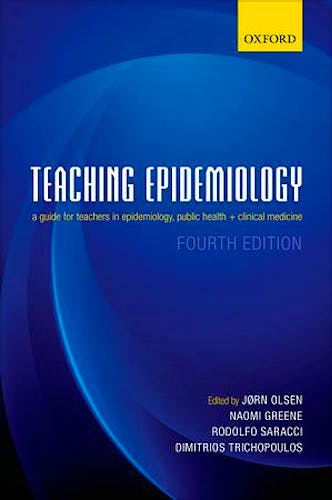

No hay productos en el carrito



Teaching Epidemiology. a Guide for Teachers in Epidemiology, Public Health and Clinical Medicine
Olsen, J. — Greene, N. — Saracci, R. — Trichopoulos, D.
4ª Edición Mayo 2015
Inglés
Tapa blanda
544 pags
1200 gr
15 x 23 x null cm
ISBN 9780199685004
Editorial OXFORD
LIBRO IMPRESO
-5%
108,24 €102,83 €IVA incluido
104,08 €98,88 €IVA no incluido
Recíbelo en un plazo de
2 - 3 semanas
Description
Teaching epidemiology requires skill and knowledge, combined with a clear teaching strategy and good pedagogic skills. The general advice is simple: if you are not an expert on a topic, try to enrich your background knowledge before you start teaching. The new edition ofTeaching Epidemiology helps you to do this and, by providing world-expert teachers' advice on how best to structure teaching, providing a unique insight into what has worked in their hands. This book will help you to tailor your own epidemiology teaching programme.
The fourth edition of this established text has been fully revised and updated, drawing on new research findings and recently developed methods including research technologies in genetic epidemiology and method development in relation to causal analysis. Analytical tools provide teachers in the field with the skills to guide students at both undergraduate and postgraduate levels. Each chapter in Teaching Epidemiology comprises key concepts in epidemiology, subject specific methodologies, and disease specific issues, to provide expert assistance in the teaching of a wide range of epidemiology courses.
- Provides an introduction to recent experience and access to high-level expert advice.
- A comprehensive guide for young and inexperienced teachers of epidemiology. It covers general methodology as well of more specialized topics related to diseases and health determinants.
- Each chapter contains guidelines for how a course in the topic could be structured and how achievements could be evaluated. A list of key references is given for such chapters.
- All the chapters are written by leading epidemiologists in their field, often with many years of teaching experience and different levels.
Table of Contents
Part 1: Context
1. Introducing the history of epidemiology, Rodolfo Saracci
2. Important concepts in epidemiology, Olli S. Miettinen
3. Study Design, Jorn Olsen and Olga Basso
4. Statistics in epidemiology, Per Kragh Andersen
5. Teaching a first course in epidemiologic principles and methods, Kenneth
J. Rothman and Sherri O. Stuver
Part 2: Exposure-oriented Epidemiology
6. Questionnaires in epidemiology, Jakob Bue Bjorner and Jorn Olsen
7. Environment, Anders Ahlbom
8. Occupational epidemiology, Neil Pearce
9. Life course epidemiology, Yoav Ben-Shlomo and Diana Kuh
10. Pharmacoepidemiology, Susan Jick
11. Nutritional epidemiology, Walter C. Willett
12. Genetic epidemiology, Harry Campbell and Susan Service
13. Teaching molecular epidemiology, Betsy Foxman
14. Social inequalities in health, Nancy Krieger
15. Climate change and human health: issues for teacher and classroom, Ulisses
Confalonieri and Shilu Tong
Part 3: Outcome-oriented Epidemiology
16. Infectious disease epidemiology, Marc Lipsitch
17. Cancer epidemiology, Pagona Lagiou and Dimitrios Trichopoulos
18. Teaching a course in psychiatric epidemiology, Rebecca Fuhrer and Kelly
K. Anderson
19. Neurologic diseases, C. A. Molgaard, A. L. Golbeck, and J. F. Rothrock
20. Reproductive epidemiology, Jorn Olsen and Ellen Aagaard Nohr
21. Teaching chronic respiratory disease epidemiology, Josep M. Anto
22. Epidemiology of injuries, Eleni Petridou, Patricia Gerakopoulou and Constantine
N.Antonopoulos
23. Dental epidemiology, Georgios Tsakos and Vibeke Baelum
24. Clinical epidemiology, John A. Baron, Henrik Toft Sorensen, and Harold C.
Sox, Jr.
25. Study of clustering and outbreaks, Paul Elliott and Anna Hansell
26. Registries and medical databases, Henrik Toft Sorensen And John A. Baron
27. Teaching epidemiology inside and outside the classroom, J. H. Abrahamson
Part 4: Pedagogies
28. Guide for teaching assistants in a methods course at a department of epidemiology,Naomi
Greene and Tarun Bhatnagar
Author Information
Jorn Olsen, Professor and Chair, UCLA School of Public Heath, California, USA and Professor, University of Aarhus, Denmark,Naomi Greene, Assistant Researcher, Department of Epidemiology, Fielding School of Public Health, University of California, Los Angeles,Rodolfo Saracci, Director of Research in Epidemiology, National Council, Pisa, Italy; Adjunct Professor of Epidemiology, University of Aarhus, Denmark and Scientific Consultant, International Agency for Research on Cancer (IARC), Lyon, France,Dimitrios Trichopoulos, Vincent L. Gregory Professor of Cancer Prevention and Professor of Epidemiology, Harvard School of Public Health, Boston, USA
Jorn Olsen is Professor of Epidemiology at AU, SDU and UCLA. Have published books and articles in several fields of epidemiology but most of the work has been in reproductive health.
Naomi Greene holds a Ph.D in Epidemiology and MPH in Community Health Sciences from the UCLA Fielding School of Public Health. She has an extensive clinical background in maternal and child health which guides her research interest in lifecourse epidemiology and the Developmental Origins of Health and Disease.
Dimitrios Trichopoulos MD, PhD, is Professor of Cancer Prevention and Professor of Epidemiology at the Harvard School of Public Health. He is Member of the Athens Academy and President of the Hellenic Health Foundation, Greece. He has served as director of the Harvard Center for Cancer Prevention; chairman of the Epidemiology Departments at the University of Athens and at Harvard; and adjunct professor of medical
© 2025 Axón Librería S.L.
2.149.0